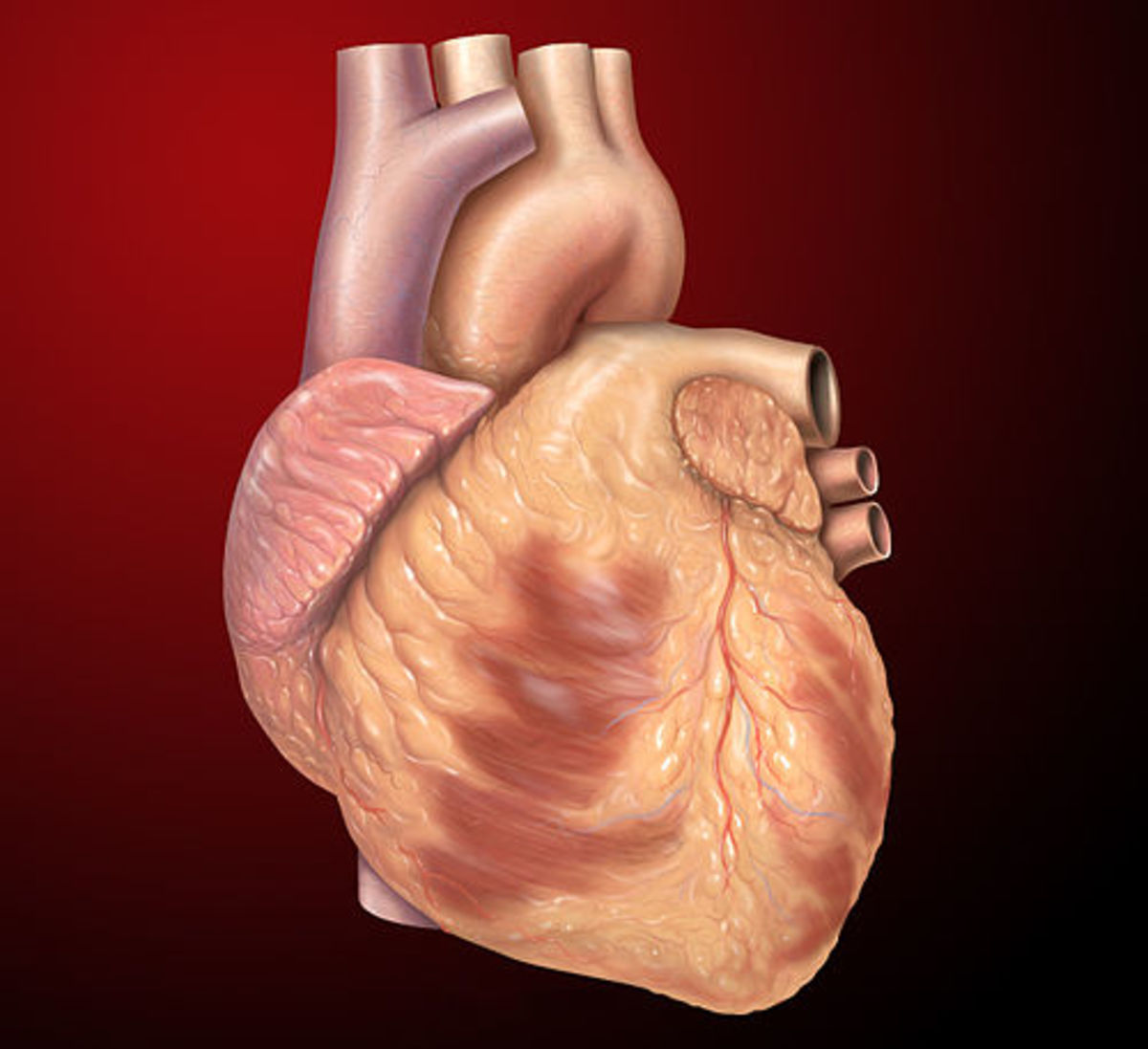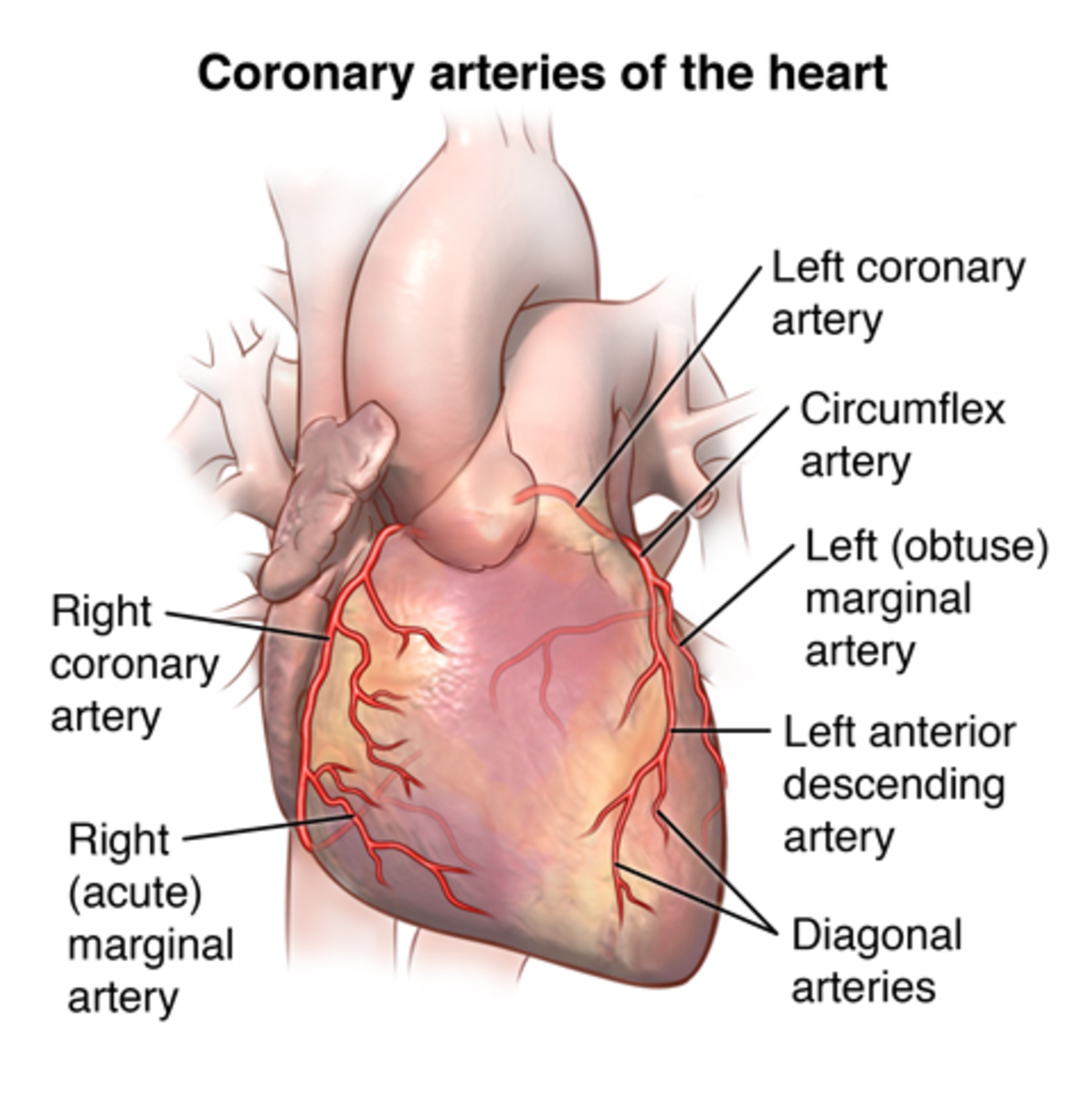Risk Factors for Heart Disease
Risk Factors for Heart Disease
Cardiovascular disease is any disease of the heart, which is cardio, and blood vessels which is vascular, so the combination of heart and vascular disease is cardiovascular disease. Some examples of it are coronary artery disease; it is a problem when anyone has a blockage in the arteries. Cholesterol blockage fills up the artery, and clogs up the blood flow to the heart muscle and as a result causes problems like heart attack, congestive heart failure. This is the most common form of cardiovascular or coronary artery disease. Arteriosclerosis is also the same process that causes coronary artery disease, but it can be found in a lot of different vessels; it can be found in carotid arteries, it can be found in leg arteries, which is commonly termed as PAD (arteriosclerosis, or cholesterol blockage in the blood vessels). Congestive heart failure is an outcome of blocked arteries and is a part of cardiovascular disease. The cardiovascular disease is a big bag of diagnosis of coronary artery disease being the main one in it.
In age group in between 20 to 40, about 10 to 15% prevalence of coronary artery disease or cardiovascular disease is seen in that age group. As you get older once you are in the 50 to 60 range it jumps to about 40%, which means that 40% of the people in that age group have cardiovascular disease. It does not escape anyone. It is prevalent even if one looks at large populations. The slightly older generation between 60 and 80 the prevalence goes up to about 70%. Once you are 80+ it is over 80%, so almost 8 out of 10 people who are about age 80 have cardiovascular disease. It is a condition that as you get older you have high prevalence of it. So that is why it is of importance for us to learn about it and know about it and see how we can be in the remainder 20 and 30% and also see if we can somehow fight it, and not be victims of it.
We have identified the cardiovascular disease does exist, now does it cause a problem that is important to know. If you look at the deaths caused from cardiovascular disease, more than half of the deaths are due to the blockages in the arteries of the heart. In fact, if one ends up eating half a pizza on a regular basis the chance of that person having a coronary artery disease is more. The other forms of heart disease are stroke, heart failure, and hypertension.
Does the heart disease actually cause problems, does it kill people, is it a significant cause of death, is this a cause of death that we need to be concerned about, or is it just something rare like the bird flu virus? In the years between 2008 and 2009, close to 400,000 men died of heart disease, and it was the leading cause of death. So, the answer is YES, it is a concern that we should all be aware of.
Let us move on to the women, if you ask any woman who is educated, or not educated, they say that their biggest risk that they perceive is breast cancer. All cancers combined are a distant second; this is breast cancer, colon cancer, or any kind of cancer combined. The other interesting thing is that in 2008, more women died of heart disease than men when in actuality most of us have grown up to believe that heart disease is a men’s disease. It somehow sort of skips the women. If one looks at the trend from 1975 to 2005, which shows that somewhere in the early 80s, the graph changed; men were dying more from heart disease, and women were not dying, or less so, but in early 80s, women took over in terms of heart disease. The key thing that caused the women to take over the men is that women started smoking in the 70s and late 80, and that is how they caught up with risk of heart disease. If one looks at the death rate of women right now it is still comparable to the late 80s in terms of where we were with men. This clearly shows that we are not doing as good of a job in identifying, educating, raising awareness, and treating women with heart disease.
Researchers are making advances in treating heart disease, but it definitely has a high prevalence as you get older. The arteries of the heart sit on top of the heart muscle. It is like an octopus and circling a ball, and ball being the heart. The heart muscle is a fleshy muscle organ. The most common symptom of heart disease is chest pain, or chest discomfort, which is termed angina, which is the medical terminology and that occurs because of either plaque formation, or spasm, or shrinkage of the arteries of the heart. The plaque formation does not happen overnight. It happens over decades. It has a slow progression; it starts building up. In fact, unfortunately, due to the bad diet, and we are now finding that children as young as two years old are starting to get fatty deposits in their arteries. This phenomenon can also be seen in children whose parents smoked in the house, in the car, and they have early formation of plaque, but as plaque forms, as cholesterol goes in the walls of artery it starts chewing up on the wall, and it creates all these blood clot formation, which sort of grow overtime, and create the blockages. So that is how blockages are formed. When one has a severe blockage, you have either a stent, or a bypass done. If there is a complete blockage the entire area of heart muscle which is dusky or purplish in color would lose the blood supply, and eventually end up having a heart attack. It is important to recognize the signs and symptoms of heart attack, so that you can prevent the death of the heart muscle.
Oftentimes just like you have the plumbing, which are the blood vessels of the heart, you also have the nerves of the heart, and sometimes on an EKG, a doctor may tell you that you have a right bundle branch block or something like that. It is a long terminology, but most people then think that there is a blockage in their plumbing, but the blockage is actually in the nerves. It is important to ask the doctors when they say a blockage, is this a blockage in the electrical system, or the conduction system, or a blockage in the blood vessel.
There are slightly different types of symptoms that women experience. Men tend to have chest tightness, pressure, squeezing of the chest, there is discomfort in the arms, shoulder, neck, jaw, shortness of breath, the person feels fatigued, cold sweats, and nausea. Those are some of the symptoms of having angina, or heart disease.
In women the symptoms are slightly different. They could have the same symptoms, but more often they have some atypical symptoms, and the symptoms are pain in the upper back, in the jaw, neck, shortness of breath, flu-like symptoms, feeling a little anxious, loss of appetite, just fatigue, discomfort.
I am attempting to not only tell you what puts you at risk, but how you can change or modify your risk so that you can change the outcome. There are some risk factors that you cannot change, like increasing age, family history, race, if you had a prior heart attack, or stroke sitting in the room, one cannot change all those things. The most easiest thing to change, probably not the easiest, but the one that makes the most sense is smoking, high blood pressure, control of it, obesity, high cholesterol, diabetes, and inactivity.
There are some other forms of heart disease, like congestive heart failure, it is a complication of the heart disease and the risk factors for congestive heart failure are the same things that cause heart disease, smoking, hypertension, obesity, high cholesterol, diabetes and inactivity, but in addition, the patient may have a heart valve problem. If you an excessive amount of alcohol intake, if you have some types of infections, viral infections in general, or if they have congenital heart disease those are conditions you are born with, those can cause congestive heart failure. Atrial fibrillation is a very common condition once you pass 60, and the same risk factors apply to atrial fibrillation, but one of the risk factors identified is sleep apnea. People who have sleep apnea tend to have irregular heartbeat, or atrial fibrillation, valve disease whether it is something that you are born with, or an infection can cause that too. Smoking, what it does is plaque formation in your blood vessels. It can cause blood clots to form. It reduces the good cholesterol, which is HDL cholesterol. It can also cause an irregular heart rhythm. It increases blood pressure. It does a lot of bad things. In addition, we know that smoking causes a lot of different types of cancer.
If a person stops smoking his or her risk decreases by 30% in two years. In a short period of time in two years you have already overcome one-third of it, it has gone, and once you get about ten years, the risk is as low as someone who is a non-smoker, so there is a good reason to stop smoking.
18% of students, grade 9 to 12 report being current smokers, and among adults 21% of men and 17% of women are smokers. How bad is smoking? People who smoke socially they enjoy it. They would say that it helps them relax, it helps them lose weight, they always talk about the positives. If you have never smoked your risk is 1, which is normal, you do not have much risk. If you smoke 1 to 14 cigarettes per day your risk goes up by 3 times, but if you smoke 15 cigarettes per day it goes up to almost 5-1/2 times. So as you smoke more your risk steadily goes up.
The treatment for smoking is the same for men and women, and men and women respond differently to the outcomes of smoking. Women face some specific barriers to creating smoking, and that is depression, which promotes or puts them back into smoking, and they are also concerned about weight gain which happens for the first year when you stop smoking, which tends to go away after that.
Overweight individuals are at a risk for developing other factors too, because you can develop high blood pressure, you can develop diabetes, and the risk is much greater if your weight is around the stomach instead of around the hips. A minimal weight loss 5 to 10% of body weight helps reduce risk of heart disease and control diabetes, just a small change makes a big difference.
In terms of physical activity the American Heart Association founded in the year 2011, only 21% of adults met the federal guidelines for physical activity. So only 1 in 5 people actually exercise as much as we should, and among 9 kids 9 through 12 grades only 28% met the recommendation.
When you look at weight loss and obesity a universal number that every one follows is the body mass index (BMI). In general a BMI from 19 to 25 is considered normal, less than 19 you are underweight, and if you are less than 16 that is when the diagnosis of anorexia and malnourished come into place. If you are over 25 between 25 to 26, you are slightly overweight, and then as you go higher and higher you go to obesity, morbid obesity, so on and so forth.
Does body weight cause you to have higher mortality from heart disease, if it did not make a difference why lose weight? If you are in the normal 19, to 25 BMI, your risk is 1, which is normal. As you start gaining weight, and your BMI increases you can see that your risk of heart disease goes up as well. So, the more you smoke, the higher your heart disease mortality, the more you weight gain, the higher your heart disease mortality. So there is always a good benefit from losing weight.
Women who have gained weight about 20 kilos since age 18 their risk of heart disease mortality is 2.6%, but if you gain more than 20 kilos your risk is much higher.
Today less than 1% of U.S. adults meet the definition for “Ideally Healthy Diet.” That is pretty depressing. No children meet that goal. Of the five components of a healthy diet, reducing sodium, which is we have a high sodium intake in a lot of foods, and increasing the whole grains which we lack unless you have a vegetarian diet.
The estimated prevalence currently of overweight and obesity in U.S. adults is 155 million, which represents 68% of the population. Among children, 32% are overweight, and obese (24 million children), and 17% are obese (13 million children). So, it is obvious to tell that one in five children fall in that category.
Gaining weight is bad, but how about if we lose weight by exercising? MET is a metabolic equivalent that measures how much exercise you are doing, so the more exercise you do, your risk of heart disease, or the risk of prevalence of heart disease steadily goes down.
How much physical activity should one do? If you talk to a doctor they say go out for a walk, go running, but how much do you really need to do? So these are following recommendations:
Consistently encourage the following:
- Moderate exercise – 150 minutes per week, OR
- Vigorous exercise – 75 minutes per week, OR
- An equivalent combination of the two.
- Aerobic exercise should be performed in episodes of at least 10 minutes, preferably spread throughout the week.
- Muscle strengthening activities that involve all major muscle groups should be performed 2 or more days/week.
Moderate exercise includes:
- Dancing fast for 30 minutes.
- Raking leaves for 30 minutes.
- Gardening for 30-45 minutes.
- Pushing a stroller 1 mile in 30 minutes.
What is the most recommended is brisk walking for just 10 minutes a day, every day in the week. A healthy diet is also important.
Healthy food selections:
- Fruits and vegetables (serving 1 cup raw leafy vegetable, ½ cup cut-up raw or 1 medium fruit).
- Whole grains, higher fiber (1 serving = 1 sliced bread. 1 oz dry cereal, or ½ cup cooked rice, pasta, or cereal (all whole-grain).
- Fish, especially oily fish, Salmon, at least twice per week (1 serving = 3.5 oz cooked).
- No more than one drink of alcohol per day.
- Less than 1500 mg of sodium per day.
- Limit fried foods, saturated fats, pastries, breads.
- Limit sugar and trans fatty acids.
High levels of bad (LDL) cholesterol and triglycerides (TG’s) increase the risk of heart disease. Low level of (HDL) cholesterol is a stronger predictor of heart disease mortality in women than men.
Most of the cholesterol in the body is made in the liver, and the small intestine. The other source is fat content in food.
Cholesterol is essential for:
- Vital for cellular function.
- Synthesis of hormones.
- Helps in absorption of fat.
- Helps in absorption of vitamin D.
The LDL cholesterol is bad cholesterol that goes around the blood stream, and starts taking the cholesterol in different parts of the vessels. HDL is something that comes and scrapes off all the cholesterol from the rest of the body. One obviously needs more HDL, and less LDL. There is also a lot of struggle in terms of raising the HDL because one always wants more cholesterol that is cleaning the system, and things that lower the HDL are, smoking, obesity, not having proper exercise, using any steroids, that is the main reason that athletes end up having heart problems because they use steroids and use a low HDL. There are certain genetic disorders that can do that as well.
Risk factor for heart disease is associated with high association with diabetes, kidney failure, steroid use, drugs, and alcohol. A very important available solution for high cholesterol is a statin, or a cholesterol-lowering medication. Statins are the most common agents used to lower cholesterol rate in the body, death rate, heart attack, and stroke.
A Holter monitor is recommended if you are having heart palpitations, or you are having episodes of dizziness, if you have had an episode of passing out, or if you feel that even when you are at rest and you are not anxious, you are comfortable, your heart feels like it is racing. Those are the times when a Holter would be recommended.
In short, life is very precious, let us make it enjoyable and try to live longer without any problems.
This content is accurate and true to the best of the author’s knowledge and is not meant to substitute for formal and individualized advice from a qualified professional.
© 2020 Putcha Venu Madhav








